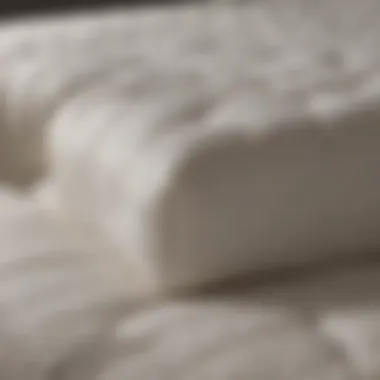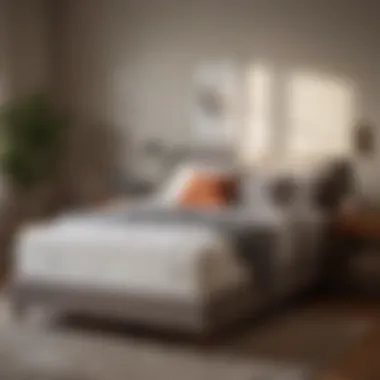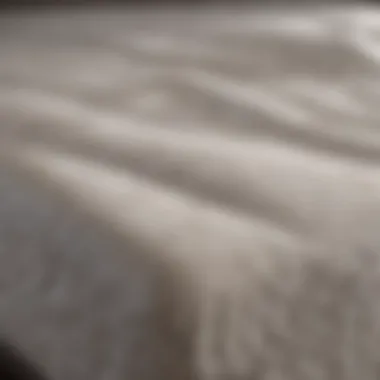Exploring Hypoallergenic Twin Mattress Covers: Key Considerations


Intro
As we spend a significant part of our lives sleeping, the quality of our sleep greatly affects our daily well-being. One often overlooked yet crucial component of this resting environment is the mattress cover. Among the various options available, hypoallergenic twin mattress covers have gained popularity due to their unique benefits and ability to create a healthier sleeping environment.
This article aims to provide you with insightful details regarding hypoallergenic twin mattress covers, examining their key benefits, materials used, and practical considerations for consumers. Understanding what makes a mattress cover hypoallergenic can be essential for enhancing sleep quality, especially for those with allergies or sensitivities. In a world where comfort and health intersect, these covers present an opportunity to improve personal sleep spaces significantly.
By focusing on the right materials, maintenance tips, and their overall impact, we will assist housewives and homeowners in making informed choices that enhance their personal spaces for ultimate comfort and well-being.
Understanding Hypoallergenic Mattress Covers
Hypoallergenic mattress covers are critical for many individuals seeking improved sleep environments. The term hypoallergenic refers to products that are designed to minimize allergy risks. They serve a key purpose in creating a sleep space that reduces exposure to common household allergens such as dust mites, mold, and pet dander. For people with sensitivities, asthma, or other respiratory conditions, selecting a hypoallergenic option is not just a preference but a necessity.
One significant aspect is the materials used in these covers. Many are made from organic fibers or treated textiles that repel allergens. These materials contribute to a healthier sleeping environment by acting as a barrier. Additionally, hypoallergenic covers often come with protective qualities, such as being water-resistant, which adds to their practicality.
Furthermore, the importance of understanding hypoallergenic mattress covers extends beyond their immediate benefits. Consumers need to know who can benefit the most from these products. For homeowners striving to create a sanctuary from environmental irritants, these covers are essential tools. They serve both functional and psychological roles that enhance peace of mind while sleeping.
As this article progresses, it will explore various materials used in hypoallergenic covers, the benefits they provide, and practical insights for selection and maintenance. This comprehensive approach will enable discerning readers to make informed choices for their own sleep environments.
Definition and Purpose
The definition of hypoallergenic mattress covers is straightforward. They are designed to prevent the accumulation of allergens that could trigger allergic reactions or exacerbate pre-existing conditions. The primary purpose is to act as a physical barrier between a sleeper and potential irritants found in mattresses.
These covers not only repel allergens but also facilitate easier cleaning and maintenance. By using a hypoallergenic cover, the lifespan of the mattress can be extended. In addition, it simplifies the upkeep by reducing the need for frequent deep cleanings of the mattress itself.
Who Should Consider Hypoallergenic Options
Hypoallergenic options are particularly beneficial for certain groups of individuals. First and foremost, those with allergies or asthma should take an interest in these products. Exposure to allergens during sleep can lead to significant discomfort, impacting overall health and well-being.
Families with young children or infants may also find hypoallergenic covers to be a valuable addition to their homes. Children often have sensitive skin and immune systems that can react adversely to allergens. Ensuring a sleeping environment free of irritants can help prevent allergy-related issues.
Moreover, pet owners might consider hypoallergenic mattress covers. Pets can introduce a range of allergens into the home. A cover designed to be hypoallergenic can help mitigate the effects of pet dander and hair, allowing families to enjoy their pets without compromising health.
Ultimately, understanding the diverse benefits of hypoallergenic mattress covers allows homeowners to tailor their sleep environments to better suit their health needs.
Materials Used in Hypoallergenic Mattress Covers
Choosing the right materials for hypoallergenic mattress covers is crucial. The fabric used can greatly influence allergen protection, comfort, and durability. A thorough understanding of these materials helps consumers make informed decisions when selecting a mattress cover.
Natural Fibers
Natural fibers are often favored for their breathability and minimal chemical treatments.
Organic Cotton
Organic cotton is a well-known fabric in bedding. It is grown without harmful pesticides or synthetic fertilizers. Its main characteristic is its breathability, which helps regulate temperature. This quality makes it a popular choice for those sensitive to allergens. The unique feature of organic cotton is its softness. This provides a gentle surface for sleep, reducing irritation for people with sensitive skin. However, one must consider that organic cotton may require careful washing to maintain its clean nature.
Bamboo
Bamboo fibers are rising in popularity for bedding. They are softer than cotton and possess inherent antimicrobial properties. This makes bamboo a beneficial choice for hypoallergenic purposes. The unique feature of bamboo fibers is their moisture-wicking ability, which keeps users dry and comfortable. On the downside, bamboo covers can sometimes be more expensive compared to traditional cotton options.


Hemp
Hemp is another natural option that should not be overlooked. It is known for its strength and durability. Hemp fabric is breathable, allowing for better airflow, which is essential for comfortable sleep. Additionally, hemp is naturally resistant to mold and mildew. This makes it a particularly good choice for hypoallergenic covers. However, hemp might be coarser than other fabrics, which some users might find less comfortable.
Synthetic Materials
While natural fibers are highly regarded, synthetic materials also play a significant role in hypoallergenic mattress covers.
Polyester
Polyester is widely used in bedding products due to its durability and resistance to shrinking. The key characteristic of polyester is its affordability and low maintenance. It can be easy to wash and dry, making it beneficial for busy households. However, some may find polyester less breathable than natural fabrics, which could affect comfort.
Nylon Blend
Nylon blends are engineered for added strength and stretch. This material often offers superior tear resistance compared to others. The blend can create a soft texture, making it an appealing option for those seeking comfort. An advantage of nylon blend is its ability to wick moisture away from the body, ensuring a dry sleep environment. Yet, like polyester, the breathability may not match that of natural fibers, raising some concerns for those prone to allergies.
Water-Resistant Options
Water-resistant mattress covers are essential for protecting against spills and accidents. They are often made from synthetics that have been treated to repel moisture. This adds a layer of protection against allergens such as dust mites and mold. While they provide a functional benefit, users should ensure they choose breathable options to maintain comfort during sleep.
Benefits of Using Hypoallergenic Twin Mattress Covers
Hypoallergenic twin mattress covers present significant advantages for those seeking a better sleep experience. This section elucidates how these covers specifically reduce allergens, enhance comfort, and prolong the life of your mattress. Such benefits create an appealing case for integrating these covers into any household environment.
Reducing Allergens
One of the primary benefits of hypoallergenic mattress covers is their ability to significantly reduce allergens. Dust mites, pet dander, and other irritants can accumulate in bedding, exacerbating allergy symptoms.
Hypoallergenic covers are often made using materials that either repel these allergens or create a barrier that prevents them from penetrating the mattress. For instance, covers crafted from tightly woven fabrics offer a level of protection unmatched by standard mattresses. By incorporating these covers, individuals can create a healthier sleep environment, potentially leading to a noticeable reduction in allergy-related issues.
"Reducing allergens in your sleep space can lead to improved breathing and overall sleep quality."
Enhancing Comfort
Beyond allergen reduction, hypoallergenic twin mattress covers also enhance overall comfort. Many of these covers are designed with specific features aimed at improving the sleeping experience. For instance, breathable materials like organic cotton or bamboo provide excellent ventilation, keeping the sleeping surface cool and comfortable.
Additionally, some hypoallergenic covers come with added cushioning or padding, offering a softer touch to the mattress. This creates a more inviting and restful space, essential for a restorative night's sleep. The dual benefit of allergy protection and comfort makes these covers an attractive option for a wide range of sleepers.
Extending Mattress Life
Utilizing a hypoallergenic mattress cover can also extend the life of your mattress. Regular use of these covers acts as a protective barrier, preventing wear and tear caused by spills, stains, and the accumulation of debris. Many high-quality covers are machine-washable, making maintenance simple. Regular cleaning reduces the risk of dirt and bacteria penetrating the mattress, preserving its integrity over time.
By minimizing damage and wear, a hypoallergenic cover can help ensure your mattress maintains its support and comfort levels for longer. Overall, investing in these covers not only enhances sleep quality but also proves to be a practical decision for maintaining your mattress's longevity.
Selecting the Right Hypoallergenic Twin Mattress Cover
Choosing the right hypoallergenic twin mattress cover is vital for maximizing comfort and ensuring a healthy sleep environment. A well-chosen cover can effectively reduce allergens like dust mites and mold. This selection process directly impacts your overall sleep quality and wellness. Factors such as size, certifications, and price all require careful consideration.
Size and Fit
Size and fit are fundamental aspects in the selection process. Mattress covers must correspond precisely to the dimensions of your mattress to provide full coverage. A cover that is too small may not protect all areas, allowing allergens easy access. Conversely, a cover that is too large could slip off, creating unnecessary inconvenience. It is essential to measure your mattress accurately, including its height, to make an informed decision. Consider brands that offer various sizes to find the best fit for your specific mattress.


Check Certifications
Certifications are an indicator of quality and safety in hypoallergenic mattress covers. Two notable certifications to look for are the Oeko-Tex Standard and CertiPUR-US.
Oeko-Tex Standard
Oeko-Tex Standard ensures that the textile used is free from harmful substances. This certification verifies that the product has undergone rigorous testing for potential irritants to human skin. A key characteristic of this standard is its commitment to sustainability and safety. Products with this certification can often be more appealing to consumers interested in environmental issues. This means your choice is not just about comfort, it is also about making a responsible choice for the planet.
CertiPUR-US
CertiPUR-US specifically pertains to foam used in mattresses and mattress covers, ensuring it is made without harmful chemicals like formaldehyde and heavy metals. This certification reflects quality and durability. A significant feature is its rigorous testing for indoor emissions, providing peace of mind for consumers. This certification is helpful for those who have sensitivities to chemicals, making CertiPUR-US a beneficial choice for hypoallergenic purposes.
Price Considerations
Price plays a critical role in decision-making. Hypoallergenic mattress covers vary significantly in cost. Higher price does not always guarantee better quality, so it is wise to analyze what features are most important to you. Consider investing in a cover that offers better durability, as it may be more cost-effective in the long run. While it may be tempting to opt for budget options, ensure that they meet quality standards to avoid potential health concerns.
Choosing the right hypoallergenic twin mattress cover requires careful thought regarding size, certifications, and price. Understanding these factors will enhance your shopping experience and ultimately lead to better sleep quality.
Caring for Your Hypoallergenic Mattress Cover
Caring for your hypoallergenic mattress cover is essential to maintain its functionality and longevity. Mattresses, due to their constant use, are often a breeding ground for allergens such as dust mites, mold, and pet dander. Thus, the right cleaning and storage methods can help in reducing these irritants significantly. By following proper care practices, consumers can ensure that their hypoallergenic covers stay effective and contribute positively to a good night’s sleep.
Cleaning Recommendations
To keep your hypoallergenic mattress cover clean, regular washing is crucial. Here are some important guidelines to consider:
- Frequency of washing: It is advisable to wash the mattress cover every two to three weeks to prevent the buildup of allergens. If you suffer from allergies, consider more frequent washes, perhaps once a week.
- Washing temperature: Always refer to the care label, but generally, washing in hot water helps eliminate dust mites effectively. A temperature of at least 130°F (54°C) is recommended.
- Detergent types: Use a gentle detergent that does not contain harsh chemicals or fragrances. Look for hypoallergenic laundry detergents to avoid adding irritants.
- Drying methods: Air drying is always preferred. However, if you must use a dryer, opt for the lowest heat setting to prevent damage to the cover materials. If possible, adding dryer balls can help separate the fabric, allowing better airflow.
- Spot cleaning: For stains or spills, promptly address them with a mixture of mild soap and water. Always do a patch test first to ensure that the fabric will not be damaged.
Remember, keeping the cover clean not only promotes a healthier sleeping environment but also lengthens the life of your mattress.
Storage Tips
If you need to store your hypoallergenic mattress cover, proper storage can preserve its properties and cleanliness. Here are some effective storage strategies:
- Clean before storing: Make sure the mattress cover is clean and completely dry before putting it away. This prevents mildew and odors from developing.
- Fold carefully: Instead of rolling, fold the cover to minimize creases. This helps maintain its shape and structural integrity.
- Use breathable containers: Store the cover in a breathable fabric bag rather than plastic. This helps prevent moisture buildup and allows airflow.
- Avoid direct sunlight: Store in a cool, dark place to shield the cover from sunlight, which can degrade materials over time.
- Check periodically: Every few months, check the storage condition to ensure no moisture or pests have compromised the cover's integrity.
Caring for your hypoallergenic mattress cover is a straightforward yet vital practice. Maintain its cleanliness and proper storage to ensure it continues to provide you with a restful, allergen-free sleeping experience.
Common Misconceptions Regarding Hypoallergenic Products
Understanding the concept of hypoallergenic products is crucial for consumers. Many people often hold misconceptions that can influence their purchasing decisions. This section addresses two prevalent myths that require clarification.
Hypoallergenic Means Allergy-Free
There is a common belief that if a product is labeled "hypoallergenic," it is completely safe for all individuals with allergies. This is misleading. The term "hypoallergenic" suggests that the product is less likely to cause an allergic reaction when compared to standard items. However, it does not guarantee that all users will be free from allergic responses.
Different people have varied sensitivities to allergens. For example, some hypoallergenic materials can still harbor particles, dust, or even compounds that trigger reactions in semi-sensitive individuals. Therefore, buyers should always consider their unique sensitivities. Products like hypoallergenic twin mattress covers may reduce allergens significantly, but they do not entirely eliminate them. Therefore, conducting personal research and possibly consulting a healthcare professional can help consumers make informed decisions about what products are right for them.
High Cost Equals High Quality


Another prevalent misconception is that a higher price tag directly correlates with better quality. While some premium products do offer exceptional benefits and durability, not all expensive items guarantee superior performance.
In the mattress cover market, many affordable hypoallergenic options perform just as well as their higher-priced counterparts. Key features often stem from the materials used and manufacturing practices rather than the price.
Consider evaluating multiple products by looking for certifications and reading user reviews. Sometimes, brands leverage marketing strategies to inflate prices based on the perceived value of being "hypoallergenic." Always interrogate whether the additional cost reflects improved functionality or is simply a pricing tactic.
"Hypoallergenic does not mean allergy-free, and high cost does not equal high quality." - Consumer Advocate
Understanding these misconceptions can help consumers navigate the market more effectively, leading to better choices that meet their specific needs. By debunking these myths surrounding hypoallergenic products, buyers can feel more confident in their selections, ensuring they invest in products that align with their health and comfort objectives.
Consumer Experiences and Testimonials
Understanding consumer experiences and testimonials in the context of hypoallergenic twin mattress covers is crucial. They provide tangible insights into the performance and effectiveness of these products. When looking for mattress covers, potential buyers often rely on reviews to gauge satisfaction from existing users. This is especially pertinent for hypoallergenic options, as they cater to a specific market segment who may have health concerns related to allergens.
Studies on Sleep Quality
Several studies underscore the connection between hypoallergenic mattress covers and improved sleep quality. A key finding indicates that individuals who use hypoallergenic covers report fewer disruptions during the night. This can be attributed to the reduction of allergens such as dust mites and mold. When allergens diminish, the likelihood of nighttime allergies—such as sneezing or itching—also decreases.
Moreover, a comprehensive study has shown that people sleeping on hypoallergenic covers experience a marked improvement in overall sleep satisfaction compared to traditional mattress covers. They benefit from not only better health—owing to fewer allergy triggers—but also enhanced comfort.
"Switching to a hypoallergenic cover was a game changer for my sleep. I noticed immediate differences in comfort and less congestion in the morning."
– A satisfied user
User Feedback on Maintenance
Another important aspect of consumer testimonials is feedback on maintenance. Users often share their experiences regarding the ease or difficulty of caring for hypoallergenic mattress covers. Many consumers appreciate that hypoallergenic covers typically require less rigorous cleaning compared to standard options. They often possess materials that are not only resistant to stains but also repel dust and allergens, making it easier to maintain cleanliness.
Furthermore, reviews frequently highlight the washing instructions and durability of these covers. A common consensus among consumers is that hypoallergenic mattress covers can withstand regular washing without losing their protective qualities. Consumers often recommend those that are machine washable, emphasizing the convenience.
In summary, consumer experiences and testimonials provide valuable perspectives on the practical benefits of hypoallergenic twin mattress covers. Both sleep quality studies and user feedback on maintenance highlight the advantages these products offer, guiding prospective buyers in making informed decisions.
Future Trends in Hypoallergenic Bedding
The landscape of bedding has seen significant changes over the years, but hypoallergenic products are emerging as a necessity rather than just a preference. As more people become aware of allergies and their impact on sleep quality, the demand for hypoallergenic twin mattress covers is increasing. This section explores crucial aspects of future trends in hypoallergenic bedding, emphasizing innovations in materials and an emerging focus on overall wellness.
Innovations in Materials
Recent advancements in material technology are transforming hypoallergenic mattress covers. Manufacturers are exploring a variety of new fibers and fabrics that offer greater protection against allergens. For example, textile innovations include the development of tightly woven natural fibers and high-tech synthetic materials that repel dust mites and other allergens.
- Organic Cotton is gaining traction. It offers breathability alongside allergen resistance.
- Bamboo Fabric, known for its moisture-wicking properties, also fights against bacteria.
- Advanced Polyester Blends are being designed to be more resistant to allergens while maintaining durability.
These materials not only enhance hypoallergenic properties but also improve comfort and adaptability. With a focus on sustainability, eco-friendly materials are becoming popular. Consumers now prioritize items that contribute positively to their well-being and reduce their ecological footprint.
Increased Awareness of Wellness
Consumers today are becoming more health-conscious, which has intensified their desire for bedding that promotes wellness. The concept of wellness extends beyond mere comfort; it encapsulates the idea of creating a holistic sleeping environment.
The increased emphasis on sleep hygiene is evident in the growing popularity of hypoallergenic twin mattress covers. Homeowners are recognizing the connection between quality sleep and overall health. This shift in awareness encourages individuals to explore bedding options that support respiratory health and reduce the presence of irritants in their sleeping areas.
Moreover, educational resources about these products are more accessible. People share their experiences on platforms like Reddit or Facebook, contributing to a communal understanding of the benefits of hypoallergenic bedding.
"Choosing hypoallergenic bedding can make a significant difference in sleep quality and general well-being. It is a small investment for better health."
As the conversation around wellness continues to grow, manufacturers will likely adapt to meet these expectations, ensuring a selection of hypoallergenic products that also promote well-being.
This evolution towards greater awareness and innovative materials highlights the importance of making informed choices for sleep products, ultimately leading to enhanced comfort and a healthier lifestyle.















